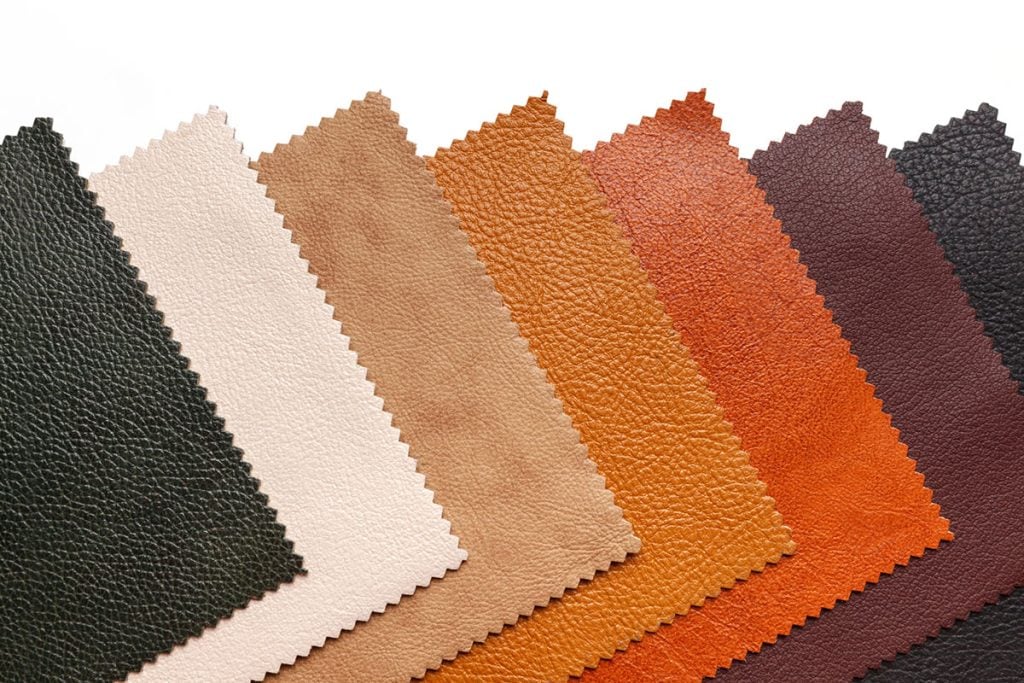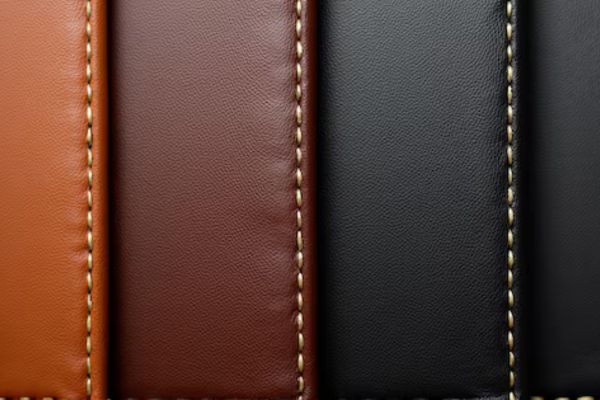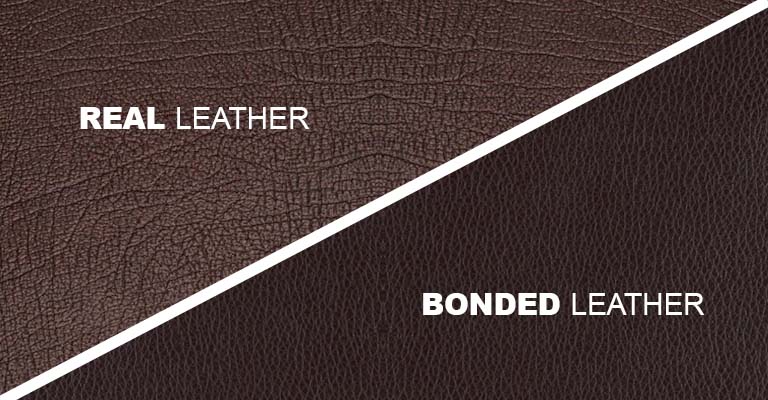Bonded leather is a material made from leather scraps and fibers bonded with polyurethane. It’s an affordable alternative but lacks genuine leather’s durability.

What Exactly Is Bonded Leather?
Bonded leather, also known as reconstituted or blended leather, is an engineered material that includes a small percentage of real leather. Think of it as the particle board of the leather world. Instead of using a solid, continuous animal hide, manufacturers take leftover scraps, shavings, and dust from tanneries, shred them into a pulp, and then bond them together using a polyurethane (PU) or latex adhesive. This mixture is then extruded onto a fiber or paper backing and embossed with a leather-like grain to mimic the appearance of a natural hide.

The final product is a composite material with a surface that is essentially a layer of plastic. While it contains leather fibers, its structure, performance, and aging characteristics are fundamentally different from traditional leathers.

The Manufacturing Process: From Scraps to Sheet
Understanding how bonded leather is made reveals why it behaves so differently from other materials. The process typically involves several key steps:
- Collection and Shredding: Leftover leather scraps and fibers are collected from tanneries. These remnants are then finely shredded into a near-pulp consistency.
- Mixing and Bonding: The shredded leather fibers are mixed with a bonding agent, most commonly polyurethane. This creates a semi-liquid slurry.
- Extrusion: The slurry is spread or pressed onto a backing material, which is usually a fabric, fiber, or paper sheet. This backing provides the structural integrity that the leather pulp lacks on its own.
- Embossing and Finishing: The surface is embossed with a uniform, repeating grain pattern to create the look of leather. Finally, a color and protective topcoat, also made of polyurethane, are applied to seal the surface.
Is Bonded Leather Considered Real Leather?
This is a common point of confusion. Legally, because it contains leather fibers (often as little as 10-20%), it can be marketed with the word “leather.” However, it is *not* a solid piece of animal hide. The properties that define high-quality leather—such as strength, breathability, and the ability to develop a rich patina over time—are absent in bonded leather. Its surface is a polymer coating, and its core is a bonded composite, meaning it will peel and crack rather than age gracefully.
Key Characteristics of Bonded Leather: Pros and Cons
Like any material, bonded leather has a set of attributes that make it suitable for certain applications and completely wrong for others. Objectively assessing these points is key to making an informed purchasing decision.
The Advantages: Why Someone Might Choose It
The primary driver behind the popularity of bonded leather is its low cost. It offers the *look* of leather for a fraction of the price of higher-grade materials. Its other benefits include:
- Uniform Appearance: The manufacturing process creates a perfectly consistent color and grain pattern, which can be desirable for mass-produced furniture where every piece needs to look identical.
- Variety of Colors: Since the color is applied to the surface, bonded leather can be produced in a vast spectrum of hues that may not be achievable with natural dyes on real leather.
- Easy Initial Cleaning: The non-porous polyurethane topcoat makes it easy to wipe away spills initially.
The Disadvantages: Common Points of Failure
The drawbacks of bonded leather are significant, particularly concerning long-term performance and value. These issues stem directly from its composite construction.
- Poor Durability: This is its most critical flaw. The polyurethane surface is prone to *delamination*, where it separates from the fiber backing. This results in peeling, flaking, and cracking, often within just 1-3 years of regular use.
- Lack of Breathability: The plastic coating prevents air from passing through, making it feel hot and sticky in warm weather and cold in the winter.
- No Patina: Unlike quality leathers that develop a unique and beautiful patina with age, bonded leather simply deteriorates. Its color may fade, and its surface will break down, diminishing its appearance over time.
- Susceptibility to Punctures and Scratches: The thin top layer can be easily punctured or scratched, revealing the fibrous backing underneath. These repairs are often impossible to conceal.
Bonded Leather vs. Other Materials: A Head-to-Head Comparison
To truly understand bonded leather’s place in the market, it is essential to compare it directly to its common alternatives, from fully synthetic options to authentic, high-quality hides.
Bonded Leather vs. PU and PVC (Faux) Leather
Faux leather is a fully synthetic material with no leather content. PU (polyurethane) leather is softer, more flexible, and more breathable than PVC (polyvinyl chloride) leather. The main difference is that bonded leather contains a backing of leather fibers, whereas faux leather uses a 100% fabric backing (like cotton or polyester). While both have a plastic surface, high-quality PU leather can sometimes outlast bonded leather because it is not prone to the same type of delamination issue. Bonded leather often peels in large sheets, while PU leather may develop smaller cracks over time.
Bonded Leather vs. “Genuine Leather”
The term “Genuine Leather” can be misleading. While it sounds premium, it is often the lowest grade of real, solid-hide leather. It is made from the lower layers of the hide (split leather) and is often corrected with a stamped grain and surface pigments. However, the crucial distinction is that genuine leather is still a single, solid piece of leather. It is significantly more durable, breathable, and robust than bonded leather. It will not peel or flake apart. While it may not age as beautifully as top-grain or full-grain, it is a definitive step up in quality and longevity from any reconstituted product.
The Gold Standard: How Bonded Leather Stacks Up Against Full-Grain Leather
Full-grain leather is the highest quality leather available. It comes from the top layer of the hide and includes all the natural grain, with its inherent imperfections and character. This is the material used for premium, long-lasting goods. When compared to bonded leather, the differences are stark. Full-grain leather is incredibly strong, durable, and breathable. Instead of wearing out, it develops a rich patina, becoming more beautiful with use and time. For products that are handled daily and expected to last, such as wallets, belts, and bags, there is no substitute for this superior material. Companies dedicated to true craftsmanship, like Beldturaleather, exclusively use full-grain leather to create items designed to be cherished for a lifetime, not replaced after a few years.
| Material | Composition | Durability | Feel & Texture | Cost |
|---|---|---|---|---|
| Bonded Leather | Leather scraps + polyurethane on a fiber backing | Very Low (Prone to peeling/cracking) | Stiff, plastic-like, uniform grain | Very Low |
| PU (Faux) Leather | Polyurethane coating on a fabric backing | Low to Medium | Softer, more flexible than PVC | Low |
| Genuine Leather | A solid piece from the lower layers of the hide | Medium | Stiffer, often with a corrected grain | Medium |
| Full-Grain Leather | A solid piece from the top layer of the hide | Very High (Lasts for decades) | Natural, soft, breathable, unique grain | High |
How to Identify Bonded Leather and Its Alternatives
Knowing what to look for can save you from the disappointment of a product that fails prematurely. When you are shopping, use your senses and check the product details to determine what you are really buying.
Telltale Signs: Smell, Texture, and Edges
First, consider the smell. Bonded leather often has a distinct chemical or plastic-like odor due to the heavy use of polyurethane. High-quality leather has a rich, earthy aroma. Next, examine the texture. Bonded leather has a repeating, unnaturally perfect grain pattern. Full-grain leather will have minor imperfections, pores, and unique variations, which are marks of authenticity. Finally, look at the edges of the material if possible. Bonded leather will have a smooth, synthetic-looking edge, while real leather will have a fibrous, suede-like texture on its unfinished side.
Reading the Label: What to Look For
Pay close attention to the product tag or description. Terms like “reconstituted leather,” “blended leather,” or “bonded leather” are clear indicators. Be wary of vague phrases like “made with leather fibers” or “man-made materials.” If a product is made from a high-quality hide, the manufacturer will proudly state that it is “Full-Grain Leather” or “Top-Grain Leather.” A low price tag for a large item, like a sofa, is also a significant red flag.
Durability and Lifespan: What to Realistically Expect
The lifespan of a bonded leather product is its greatest weakness. For items that see frequent use, such as a family couch or an office chair, signs of wear can appear in as little as one year. The polyurethane surface, which bears all the stress of friction and flexing, begins to separate from the leather-fiber backing. This leads to the characteristic peeling and flaking that bonded leather is infamous for. Once this process begins, it is irreversible and rapidly worsens, making the item look worn and unsightly.
In contrast, an item made from full-grain leather is an investment in longevity. With proper care, a full-grain leather wallet, bag, or belt will not only last for decades but will also improve with age. It withstands daily use, resists tearing, and develops character. This vast difference in lifespan highlights the long-term value of choosing a superior material from the outset.
Making an Informed Choice for Your Leather Goods
Ultimately, the choice of material depends on your priorities. If budget is the single most important factor and longevity is not a concern, bonded leather can provide a specific aesthetic for a very low initial cost. It might be suitable for decorative items or pieces that will receive very little physical contact.
However, for any item intended for regular use and long-term enjoyment, the trade-off in durability is too great. The frustration of watching a product peel and fall apart after only a short time far outweighs the initial savings. For functional, everyday items like personal accessories, investing in a product crafted from full-grain leather is the more prudent and satisfying decision. It ensures you receive a piece that is not only beautiful and functional on day one but will remain a reliable and cherished possession for many years to come.



